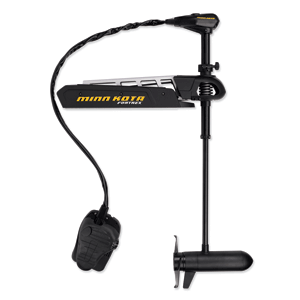What is a trolling motor used for? A trolling motor is used to navigate quietly and precisely while fishing. Unlike an outboard motor, which provides high-speed propulsion, a trolling motor operates at low speeds with electric power for better maneuverability and stealth. It is commonly mounted on the bow or transom and can be controlled by hand, foot pedal, or remote. But, of the multitude of trolling motors on the market, which one is best for you?
When selecting a trolling motor, the primary decision-making points are thrust, trolling motor voltage & batteries, bow or transom motor, hand or foot control, shaft length, saltwater or freshwater use, and budget. Let’s explore each of these areas, then look at some specific trolling motor options based on your needs and budget.
Thrust

Trolling motors use battery power in order to propel the boat and the amount of power needed to move the boat through the water is referred to as "pounds of thrust." The pounds of thrust rating is common to all trolling motors on the market and is a critical consideration for selecting an appropriate motor. Without enough power, you will not be able to maneuver your boat in high-wind conditions or within weedy areas.
How to Choose the Right Thrust for Your Trolling Motor
- Boat Size Matters: Larger boats need higher thrust power
- Weight Considerations: Factor in passengers and gear weight
- Water Conditions: Windy or rough waters require stronger motors
-
Rule of Thumb: Refer to the Minimum Thrust Required Chart for guidance
Our Minimum Thrust Required Chart on the right can serve as a general guide. But, as stated above, a more powerful engine is needed if your boat and/or load is often heavy or if you often fish in more demanding conditions.
Bow or Transom Trolling Motor
As the names suggest, a bow-mounted trolling motor is designed to be mounted on the front of your boat and a transom mount is designed to be mounted on the back of your boat. A bow-mounted motor provides better maneuverability and better control; however, you must have enough room at the front of your boat and a flat-bottom platform to fish from to make a bow-mounted setup possible. A transom mount will work within any boat.
Trolling Motor Voltage & Batteries
Trolling motors come in 12, 24, or 36 volts. 12-volt trolling motors are less expensive, but will not run as long as a 24 or 36-volt motor. However, if your boat is 16 feet or smaller, a 12-volt trolling motor will likely be sufficient. For larger boats, you will need a 24 or 36-volt motor.
Shaft Length
If you choose a trolling motor with a shaft that is too short, the prop may not be sufficiently submerged within wavy conditions. If the shaft is too long, shallow-water fishing will be a big problem. The needed shaft length is dictated by the height of the bow or stern. The rule of thumb is that the top of the motor section should be submerged 12".
Hand or Foot-Controlled Trolling Motors
Hand versus foot controls is largely an issue of personal preference and each has its pros and cons. For instance, a hand-controlled trolling motor creates no additional clutter on the deck and offers a bit more precise control. However, hand-controlled motors will require you to take your hand off of your rod and can only be used on bow-mounted motors. Foot-controlled trolling motors, on the other hand, offer hands-free use, can be used anywhere on the boat. Negatively, however, there are more parts on them to break, add clutter to your deck and there is a slower response time on some models. With these trolling motor basics out of the way, which trolling motors does PartsVu recommend? As with anything, the right trolling motor for you depends on your needs, your boat, and your budget, but we have offered some suggestions below.
Saltwater versus Freshwater Trolling Motors - What's the Difference?
Many saltwater fishermen use freshwater trolling motor models. So what really is the difference? Saltwater trolling motors are designed for increased corrosion protection and generally include stainless steel hardware, sealed electrical connections, and advanced paints for improved corrosion protection. Do be aware that use of a freshwater motor in saltwater might void the manufacturer's warranty. Rinsing and wiping down any trolling motor model after saltwater use is important and is even more important if you are using a model designed for fresh water in saltwater.
What's the difference between a trolling motor and an outboard motor?
The primary difference lies in their purpose: a trolling motor is designed for slow, precise maneuvering while fishing, whereas an outboard motor is used for propulsion at higher speeds. Trolling motors are electric-powered and mounted on the bow or transom, allowing for quiet movement, while outboard motors use gasoline or diesel and generate much more power for cruising.
|
Feature |
Trolling Motor |
Outboard Motor |
|
Purpose |
Slow, precise fishing movements |
High-speed propulsion |
|
Power Source |
Electric (battery-operated) |
Gasoline or diesel |
|
Control Method |
Hand, foot pedal, or remote |
Throttle and steering wheel |
|
Speed |
Low-speed, controlled |
High-speed for long distances |
|
Best Use Case |
Fishing, maneuvering in tight spots |
Traveling long distances on the water |
Recommended Trolling Motors
Inexpensive Options
Minn Kota Endura C2 - Transom Mount
The Minn Kota Endura C2 line is a legendary performer that's built to explore, built to last and backed up with our two-year warranty. It's the ultimate coming together of form and function, in a package that puts you on the water day after day, year after year without breaking the bank. Runs cool and quiet due to its extra-large winding and commutators that dissipate heat, resulting in cooler operation, extended battery power, and longer motor life. Additionally, their unique bearing system reduces friction to cut fish-spooking noise.
Endura C2 Line General Specs:
- 30-55 pounds of thrust
- 30-42" shaft
- 12-volt battery
MotorGuide R3 - Transom Mount
The R3 Transom mount is the ultimate in strength, rigidity and durability. The aluminum alloy construction and stainless steel hinge pins make it one of the most powerful and durable trolling motors available. Put the control at your fingertips with the R3's ergonomic extending handle and a durable multi-position angle adjustment aluminum mount. The R3 transom mount features aluminum alloy construction with a rugged powder coat finish.
MotorGuide R3 Line General Specs:
- 30-55 pounds of thrust
- 18”-42" shaft
- 12-volt battery
Minn Kota Edge - Bow Mount

Minn Kota Edge lets you step right up to treacherous stump fields, tangled weed beds, or punishing wind and waves. Big challenges like those usually mean bigger fish. And when you've got the unrelenting, rugged construction of Edge - available in foot or hand control models - you've got the power to rise to the occasion.
Minn Kota Edge Line General Specs:
- 45-70 pounds of thrust
- 36”-52" shaft
- 12 or 24-volt batteries
MotorGuide X3 - Bow Mount
The X3 trolling motor is designed to deliver better performance and durability for anglers looking for the best value in the 40- to 70-pound thrust range. The X3 offers best-in-class steering performance. A dual cable pull-pull steering system eliminates slack, while the innovative patent-pending Variable Ratio Technology reduces torque steer feedback and improves responsiveness.
MotorGuide X3 Line General Specs:
- 40-70 pounds of thrust
- 36”-50" shaft
- 12 or 24-volt batteries
Mid-Range - Great Value Trolling Motors
Minn Kota Traxxis - Transom Mount Trolling Motor
When the walleyes are biting, you'd better be on the spot. All the well-positioned casts in the world don't mean a thing if you can't stay on the fish. The Traxxis rethinks every facet of the transom-mount motor to keep you in the game, no matter where the game takes you.
Minn Kota Traxxis Line General Specs:
- 45-80 pounds of thrust
- 36”-42" shaft
- 12 or 24-volt batteries
MotorGuide X5 - Bow Mount
The X5 bow mount, cable steer motor - the latest in the growing lineup of X series motors - is MotorGuide’s most advanced, tournament-caliber motor. It's engineered to deliver best in class performance for quiet operation, rugged durability, and precise control.
MotorGuide X5 Line General Specs:
- 55-105 pounds of thrust
- 45”-60" shaft
- 12, 24, or 36-volt batteries
Minn Kota Fortrex - Bow Mount

With fewer moving parts, tighter tolerances and less give, Fortrex is the beefiest, meanest, quietest motor ever.
Minn Kota Fortrex Line General Specs:
- 80-112 pounds of thrust
- 45”-62" shaft
- 24 or 36-volt batteries
Best-In-Class Trolling Motors
Minn Kota Vantage - Transom Mount
Vantage makes sure you don't have to wait for the next cast, the next catch, and the next trophy mount. With ultra-responsive 4:1 steering and automatic stow/deploy/trim, it's always ready to go.
Minn Kota Vantage Line General Specs:
- 80-101 pounds of thrust
- Variable-length shaft
- 24 or 36-volt batteries
MotorGuide Xi5 - Bow Mount
The Xi5 is designed to exceed expectations. It's engineered to be reliable every day - and durable over the long haul. The Xi5 includes wireless capability "right out of the box", anglers can command precise motor and steering control from anywhere on the boat. A hand-held remote is standard with saltwater models. Plus, MotorGuide made it stealthy quiet, and silky smooth.
MotorGuide Xi5 Line General Specs:
- 55-105 pounds of thrust
- 45” – 60” shaft
- 12, 24 or 36-volt batteries
Minn Kota Ulterra - Bow Mount

With Auto Stow/Deploy and Power Trim, the Ulterra has a lot to get excited about. Especially once you realize it comes with your choice of i-Pilot or i-Pilot Link, a redesigned foot pedal, and Universal Sonar 2.
Minn Kota Ulterra Line General Specs:
- 80-112 pounds of thrust
- 45” – 72” shaft
- 24 or 36-volt batteries
Frequently Asked Questions About Trolling Motors
What does a trolling motor do?
A trolling motor propels the boat slowly and quietly so anglers can approach fishing spots with precision. It also provides hands-free navigation in some models with foot control or remote steering, allowing for better focus on fishing.
What is a trolling motor used for?
A trolling motor is used to maneuver a boat quietly and precisely, often while fishing. Unlike primary outboard engines, trolling motors allow for controlled, low-speed movement, helping anglers position their boat without spooking fish. They’re especially useful in shallow waters, tight spots, or for staying in one location using GPS anchor features.
How do I determine the right shaft length for my trolling motor?
To choose the right trolling motor shaft length, measure from the mounting surface (deck or transom) to the waterline. Add 16–20 inches for bow-mounted motors, or 20 inches for rough water. For transom-mount motors, ensure the motor head is submerged 12" below the waterline. This ensures efficient thrust and avoids cavitation.
Can I use a freshwater trolling motor in saltwater?
Technically yes, but it’s not recommended. Freshwater trolling motors lack corrosion-resistant coatings and sealed electronics, making them vulnerable to salt damage. Saltwater motors are specifically engineered to withstand harsh marine environments, extending their lifespan and reliability. If you do use a freshwater motor in saltwater, rinse thoroughly after every use.
What's the difference between a trolling and outboard motor?
Trolling motors are electric, smaller, and designed for precise, low-speed control. Outboard motors are larger, gas-powered (or sometimes electric), and serve as the main propulsion for higher-speed travel. Trolling motors excel at stealth and finesse, while outboards are built for power and getting from point A to point B quickly.












